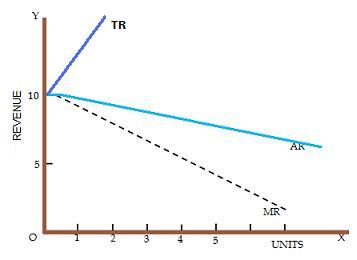Monopoly is that market category in which a single seller dominates the market. There is only one producer (firm) and there are no substitutes for its product. Since under monopoly there is just one firm producing a particular product there is no element of competition. Besides in the absence of any other firm producing homogeneous product the firm itself constitutes the industry. Hence it is futile to make any effort to distinguish between a firm and an industry under monopoly. Under Monopoly, firm is itself an industry.
The revenue structure under monopoly is bound to be different from that in case of a firm under perfect competition. Under perfect competition, the firm is a price-taker and not a price maker and its AR curve is horizontal denoted by perfectly elastic demand curve. But a monopolist is not a price-taker; he is price-maker. In order to sell more of his output he will lower the price. As the monopolist supplies more and more units of his product the price gets slightly reduced. The Total Revenue increases but a diminishing rate. The average revenue goes on falling. The marginal revenue too is falling.
| Unit of x |
Total Revenue |
Average Revenue |
Marginal Revenue |
|
1 |
10 |
10.0 |
10 |
|
2 |
19 |
9.5 |
9 |
|
3 |
27 |
9.0 |
8 |
|
4 |
34 |
8.5 |
7 |
|
5 |
40 |
8.0 |
6 |
|
6 |
45 |
7.5 |
5 |
|
7 |
49 |
7.0 |
4 |
In fact the marginal revenue is falling at a rate faster than the average revenue. When we transform the average revenue and marginal revenue readings from the Revenue Schedule into a graph, we observe;
- AR curve under monopoly slopes downwards from left to right.
- MR curve lies below AR curve and MR curve is steeper than the AR curve.
Besides this simple relation between AR and MR under monopoly there are a few significant observations which need to be highlighted.
1. The Average Revenue curve cannot cut X-axis, Marginal Revenue curve can.
The explanation is rather simple. Average revenue, as we saw earlier, is nothing but the price. If the average revenue curve touches X-axis then the price for every unit of total output is reduced to zero and if, even by mistake, the average revenue curve cuts the X-axis and goes below X-axis then the price would become negative. This would be absurd and irrational. Thus the average revenue curve cannot cut the X-axis. However, the marginal revenue curve can cut the X-axis. This is because by the very definition marginal revenue is the additional revenue from the additional unit of the output sold. The last unit could be given away free. This does happen in bulk purchases e.g. if a consumer purchases 100 units of X for 5000$ then he may be given 101st unit of X free. This implies that the Marginal Revenue of 101st unit is zero. Hence, it must be noted that the AR cannot cut X-axis, MR can.
2. Under Monopoly, if AR is in the form of a straight line then MR lies exactly half-way between AR and the Y-axis.
There exists some unique geometrical relationship between AR and MR. In case when average revenue is in the form of a straight line i.e. if AR is a straight line then MR lies half way between AR and the Y-axis. ie. PQ =QR

